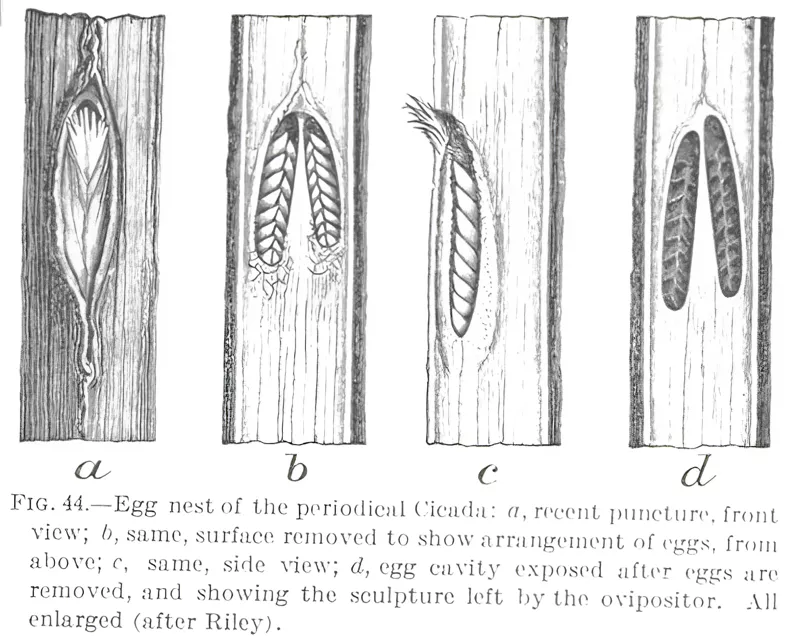Cicada eggs and first instar nymph photos by Roy Troutman:
Cicada Eggs:

First instar cicada nymphs:

Cicada eggs and first instar nymph photos by Roy Troutman:
Cicada Eggs:

First instar cicada nymphs:

It’s been about six weeks since the emergence of Brood VIII in Pennsylvania, Ohio, West Virginia and Oklahoma. Now (first week of August) is a good a time as any to check for periodical cicada nymphs that have hatched from eggs laid in branches. Once they hatch they’ll find their way to the ground, where they’ll find and begin feeding on roots for the next 17 years.
Look on branches where cicada laid their eggs.
An illustration of egg nests (Marlatt 1907 Egg Nest Detail):

A nymph on a branch with adult male finger for comparison:
Close up:
Another close up:
This video by Roy Troutman shows a Tibicen cicada nymph emerge from the ground.
Annual cicada nymph emerging from burrow. from Roy Troutman.
The Simon Lab is dedicated to the study of cicadas, in particular, periodical cicadas.
One of the things they study is the development of cicada nymphs while they are underground.
They need your help to collect cicada nymph specimens. You would dig for them, and if you find them, mail them to the Simon Lab. The nymphs will be used for valuable scientific study, so the loss of a few from your yard will not be in vain.
If you are interested in participating in cicada nymph research, visit The Simon Lab Nymph Tracking Project page for more information. You must have had periodical cicadas on your property in past 13 or 17 years to find the nymphs — not including the Brood II area, since those nymphs came out of the ground this year.

I didn’t see any nymphs emerge and undergo ecdysis tonight, but I did find plenty of cicada chimneys and nymphs trapped under slates.
Cicadas build chimneys above their holes, typically after it rains a lot and the soil becomes soft. The chimneys help keep water from rushing into their holes, and they keep ants and other menaces out.



A good place to find cicada nymphs is under backyard slates (or similar objects that cover the ground). Flip over your slates and you might find a nymph tunneling their ways to the side of the slate.
Brood II 17 Year Cicada Nymph trapped under a slate from Cicada Mania on Vimeo.
Apparently cicadas serenaded the dinosaurs! Entomologist and Mount St. Joseph professor Gene Kritsky shared the news today that cicadas lived as long as 110 million years ago during the Cretaceous period.
A quote from a press release:
New research has documented that cicadas, those noisy insects that sing during the dog days of summer, have been screaming since the time of the dinosaurs.
A fossil of the oldest definitive cicada to be discovered was described by George Poinar, Jr., Ph.D., professor of zoology at Oregon State University and Gene Kritsky, Ph.D., professor of biology, at the College of Mount St. Joseph in Cincinnati. The cicada, measuring 1.26 mm in length, was named Burmacicada protera.
Read the full Press Release on the MSJ website.
Here is a photo of the ancient Burmacicada protera cicada nymph trapped in amber. Photo credit: George Poinar, Jr., Ph.D.

It looks a lot like a modern-day first-instar cicada nymph:

Photo by Roy Troutman.
Update: Here’s a video news story about Gene’s fossil find.
I need a step-up my fossil collecting hobby. It looks like there’s some places in New Jersey to find fossils. Maybe I’ll find a cicada.
Roy Troutman provided this video featuring a Magicicada nymph 12 day transformation before final molt. It’s an excellent view of what nymphs look like right before they emerge from the ground and become adults.
Magicicada nymph 12 day transformation before final molt! from Roy Troutman on Vimeo.
Elias went digging for Magicicada nymphs on 3/21. Here’s a gallery of the nymphs he found.

Here are some new photos from Roy Troutman that will give you a good idea of what to look for when searching for signs of cicadas in your yard:
This is a pair of Magicicada nymphs, much like you might find when gardening or turning over logs or stones in your yard.

See those beige globs of soil amongst the leaves and debris? Those are called cicada chimneys. They are a sure sign that a cicada nymph is below the soil, and will emerge in a few days or weeks.

Look closely at this picture and you’ll see holes in the ground. Those are holes that cicada nymphs have dug, and they’re another sure sign of where a cicada will emerge.

On May 1st we’ll start making predictions as to when they’ll start to emerge.
Here’s a photo of first instar Magicicada nymphs by Roy Troutman:

Here is video of a 1st instar magicicada nymph crawling around taken just minutes after it crawled from its egg sack:
1st instar magicicada nymph from Roy Troutman on Vimeo.
1st instar magicicada nymph in slow motion by Roy:
1st instar magicicada nymph in slow motion from Roy Troutman on Vimeo.